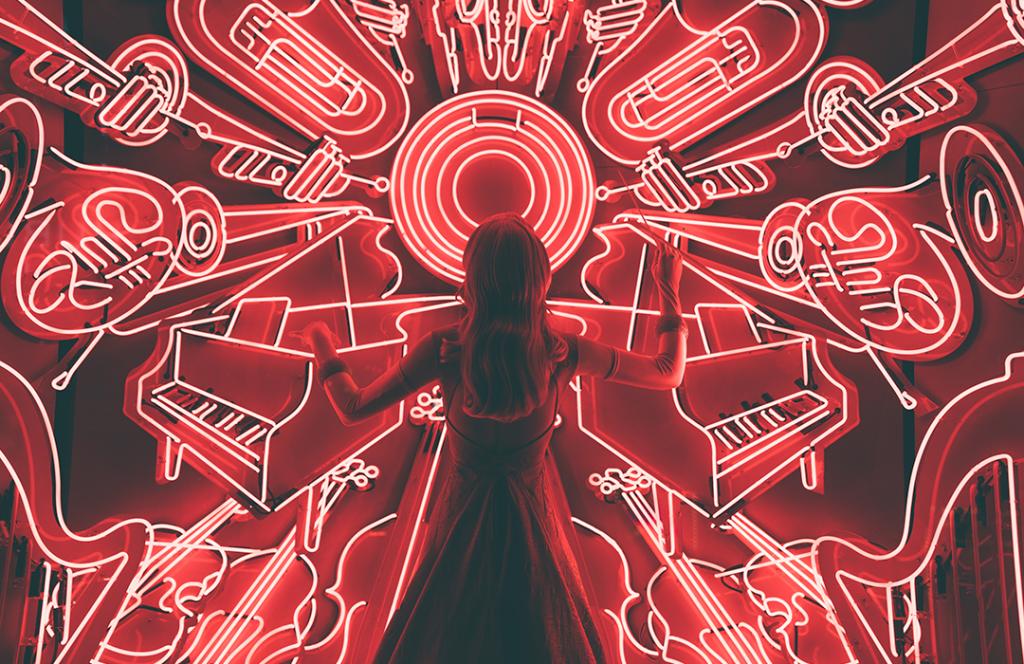"Unsuspecting listeners couldn’t tell the difference between AI renderings and the real thing."
We explore a brief history of music AI and a glimpse into its limitless future.

We’ve already seen how cinema has reacted to the rise of artificial intelligence but how is the music industry dealing with this inevitable pop-culture shift? As we gear up to debut our brand new interactive exhibition AI: More Than Human, we wanted to take the opportunity to inspect how technological leaps are changing the way creatives and consumers interact with this integral ingredient of our day-to-day lives. From software that can dream up its own bespoke melodies to suit the specific genres we know and love, to uncanny pop-stars that aren’t all they appear to be - artificial intelligence and music are here to stay and they’ve been collaborating for longer than you might think.
To discover the origins of this partnership, you’d have to go back to 1951. It was here where Northern mathematician, code-breaker and visionary computer scientist Alan Turing invented a machine that could create three simple melodies without any human assistance. As the earliest example of machine-generated music, Turing’s creation was huge (it took up his entire laboratory floor) and - unsurprisingly - limited in its abilities. While only programmed to play three tunes - the nursery rhyme ‘Baa Baa Black Sheep’, national anthem ‘God Save The King’ and Glenn Miller’s ‘In The Mood’, it was hardly Spotify - however it paved the way for big things to come within the realm of computer generated music.
Cut to the 90s and things had progressed even further. The late-great David Bowie had begun using software that generated sentences at random, helping him dream up new and unpredictable song lyrics and further cement his status as an early advocate for creative innovation. Then there was David Cope, a American composer who spent his days teaching computers how to create their own renditions of classical music in the same style as renowned greats like Bach. Through a little tinkering, Cope’s creations ultimately became so good that unsuspecting listeners couldn’t tell the difference between his AI renderings and the real thing. Inch by inch, these incremental advances were letting us glimpse the full potential of AI music creation - and the tools needed to set it on its way were becoming more readily accessible.
"An AI system developed with Sony...imagined its own Beatles-esque track ‘Daddy’s Car’."
These days, the creative partnership between creator and AI has become much more close knit. As the software needed to facilitate these collaborations made its way onto laptops, musicians like Holly Herndon took these tools and incorporated them into her work to great effect and critical acclaim. A student of composition at Stanford, Herdon pushed the boundaries of songwriting by using a brain-like neural network software called Spawn to harmonize with a virtual, free-thinking version of herself on her 2019 album Proto. Google got in on the game too, with their Magenta Project giving birth to Flow Machines, an AI system developed with Sony that imagined its own Beatles-esque track ‘Daddy’s Car’, created entirely by artificial intelligence.
Meanwhile, app developers created a range of AI-driven software that served professionals and consumers alike. When moviemakers and podcasters needed quick access to original and emotion-led incidental music, Amper harnessed AI to help them to craft exactly that. When users craved some much-needed headspace amid the digital onslaught of everyday life, Endle gave them a personalised soundscape that was influenced by their own specific environments and rendered by AI. Versions of this same learning technology can even be found on our phones. Ever wonder how Spotify’s Discovery feature always seems to know which tracks you’ll love before you do? You can thank behavior-led technology for that perk too.
"She’s even got 2.9 million fans...There’s just one problem - she’s not real."
However perhaps most unnerving of all is the rise of computer generated popstars. According to Instagram, Mequila Soul - or Lil Mequela as she’s known to her fans - is a Brazillian-American pop-star, model and social media influencer. Visit her page and you’ll find her in a variety of locations and poses to back up these claims; in the recording studio, at the beach, plugging the latest must-have beauty product. She’s even got 2.9 million fans and an on-going Insta-feud to reinforce her social credibility. There’s just one problem - she’s not real. While her creators remain anonymous, it’s obvious that this uncanny caricature of pop-stardom has captured the imagination of audiences worldwide and will likely lead to us seeing more of Mequela’s kind in the not so distant future.
With technology moving at a breakneck pace and our own collective fascination with innovation further fuelling its development, artificial intelligence and music shows no signs of slowing. Instead, it continues to open previously unknown doors and introduce us to fresh musical approaches that are created somewhere other than the human brain. Who knows - perhaps the next biggest artist or hottest band will exist solely on a computer screen and know our musical tastes considerably better than we do?
